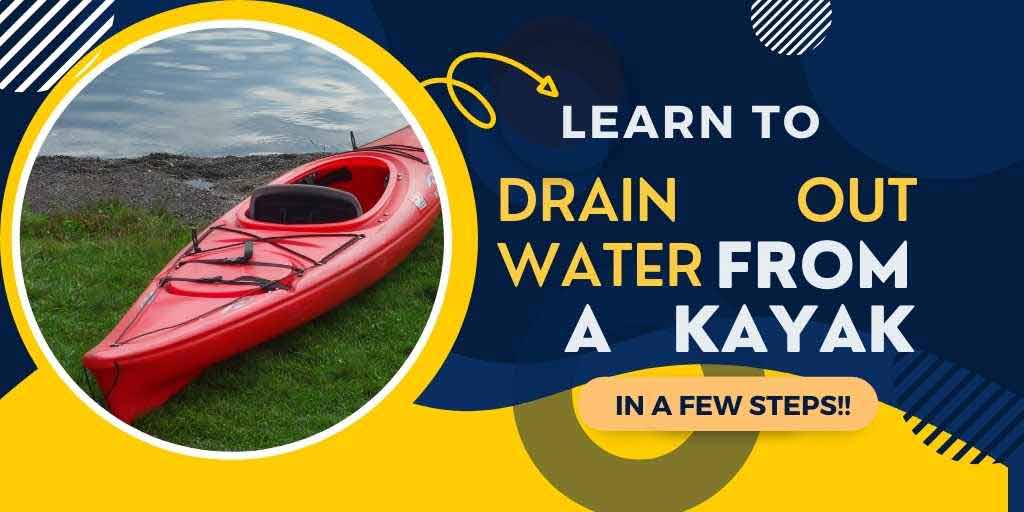Kayaking is a popular outdoor activity enjoyed by many. It is a great way to explore the waters around you, whether it be a river, lake, or ocean. However, one of the most critical aspects of kayaking is safely and effectively removing any water that gets into the cockpit of your kayak.
Knowing how to drain water out from your kayak can be an essential skill for any kayaker. If you’re a beginner kayaker or have just purchased a kayak, you may be wondering how to drain water out from your kayak.
So what’s the best way to go about draining water out from your kayak? In this article, we’ll show you the steps and techniques for draining your kayak in a few easy steps.
If you’re ready to get started, let’s dive into learning.

Jump To A Section
Step-By-Step Guide To Drain Water Out From A Kayak
If you’re not familiar with the process of draining water out from a kayak, it can be a daunting task. Fortunately, this guide will make the process easier for you.
Start by removing any items that are obstructing the drain. This could include items such as a seat, a paddle, or even a life jacket. You may also need to remove any straps or bungee cords that are attached to the kayak.
Here’s the ultimate step-by-step guide to help you do it in no time;
Step 1:
Prepare the Kayak for Draining the Water
Preparing a kayak for draining the water is a critical step in proper upkeep and maintenance. Kayaks are designed to be used in water, and even the most careful of owners may find themselves with a kayak that needs to be drained of water.
Fortunately, this process is relatively simple and can be done with the right equipment and materials.
Step 1.1:
Gathering the Necessary Equipment and Materials
Before you begin, make sure you have the essentials for draining water out of your kayak. This includes a bucket, a bilge pump, a garden hose, and a drain plug wrench.
Additionally, if you’re draining the kayak from a lake or river, you’ll need to secure a tow line to the kayak, so it doesn’t drift away.
Step 1.2:
Find the Drainage Hole and Unfasten the Drain Plug
The next step is to locate the drainage hole and unfasten the drain plug. The drainage hole is typically located at the stern of the kayak, near the bottom of the hull. Once you’ve located the drainage hole, you’ll need to use the drain plug wrench to loosen the drain plug so the water can escape.
Be sure to keep the drain plug in a safe place so it won’t get lost while draining the kayak. Additionally, be sure to pay attention to any signs of potential leaks, as these can cause the kayak to take on more water.
Step 2:
Draining Process
Drainage is an essential part of kayaking, as it helps to keep your boat clean and free of excess water.
Properly draining water from your kayak can help to protect the integrity of your vessel and maintain its performance on the water.
However, the process of draining water out from a kayak involves setting up the drains in the proper position on the kayak’s deck and gunwales, connecting a hose or tubing to one end of the drain, and opening up all of the drain valves to allow the water to escape.
Step 2.1:
Use a Hand Pump
The most reliable way to drain water out of your kayak is to use a hand pump. This will allow you to pump the water out of the kayak quickly and easily. Start by checking the area around the pump to make sure it is free from any debris or rocks that could block the pump.
Then, insert the pump’s hose into the kayak and begin pumping.
Step 2.2:
Use a Sponge or Towel
If you don’t have a hand pump, you can also use a sponge or a towel to remove the water from the kayak. Start by soaking the sponge or towel in the water and then wring it out. Then, place the sponge or towel in the kayak and start squeezing it to remove the water.
Step 2.3:
Open the Drainage Plugs
Once you’ve removed as much of the water as possible, open the drainage plugs on your kayak. Start by carefully opening each end of the plugs. Once they are open, the water should start draining from the kayak.
Step 2.4:
Let It Dry
Once the kayak is drained of water, be sure to rinse it off with fresh water and then let it dry. This is a critical step to ensure that the kayak is well-maintained and ready for its next adventure.
And this will help ensure that no mold or mildew develops. To do this, find a location with good airflow and let your kayak dry for a few hours.
That’s all it takes to drain water out of a kayak. With this step-by-step guide, you’ll be able to do it in no time at all.
Now that you know how to drain water out of your kayak, you can get back to exploring the outdoors. With the proper preparation and knowledge, you can quickly and easily remove any water from your kayak, allowing you to get back to enjoying your time out on the water.
Step 3:
Finishing Up
Whether you’re a beginner or a seasoned kayaker, it’s essential to take the necessary precautions to ensure that all the water has been drained from your kayak before closing up any drain valves or disconnecting any hoses or tubes.
The process of adequately draining water out of a kayak can be a bit tedious, but it is vital for your safety, as well as for the longevity of your kayak.
To properly finish draining your kayak, here are a few steps you should take:
Check All Drains
It’s crucial to check all of the drains. This should be done before closing up any drain valves and disconnecting hoses or tubes from them. Therefore, you need to ensure that no more water remains in any part of the kayak.
Checking all of the drains is especially important if you’ve been in shallow water, as this can cause water to be left behind in some areas of the kayak.
Close-Up Drain Valves
After you’ve checked all of the drains, the next step is to close up all drain valves and disconnect hoses or tubes from them. It’s essential to make sure all of the valves are securely closed to prevent any water from re-entering the kayak.
Once all of the valves are closed, it’s time to disconnect any hoses or tubes from them. Make sure that all of the hoses or tubes are safely stored away so as not to cause any further water damage.
Finally, after all of the steps have been completed, it’s time to take a few minutes to inspect the kayak and make sure that all of the drains and valves are properly closed, and all hoses are disconnected.
Taking an extra few minutes to double-check everything can help to ensure that no more water remains in the kayak.


